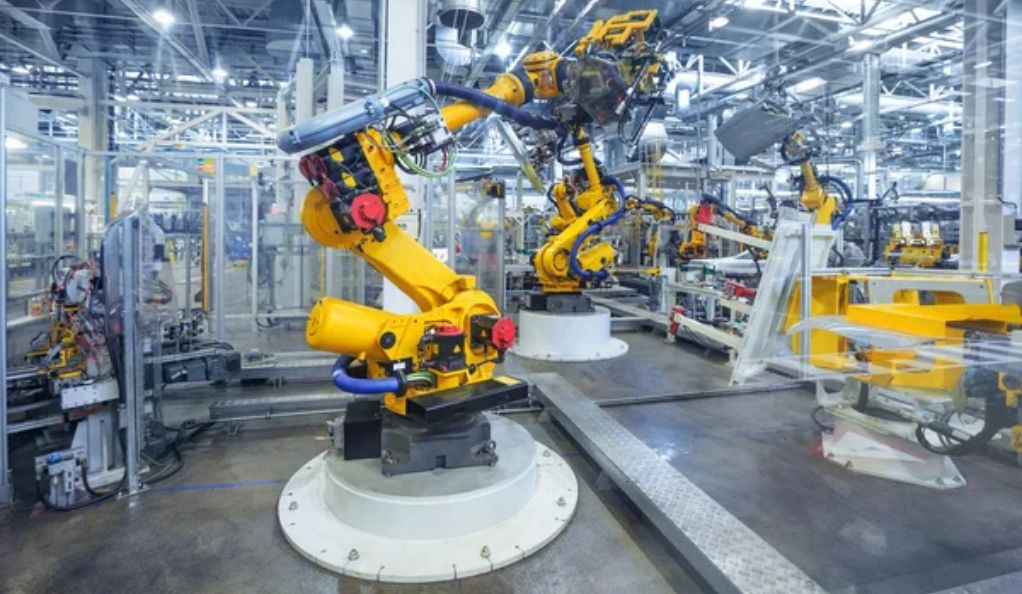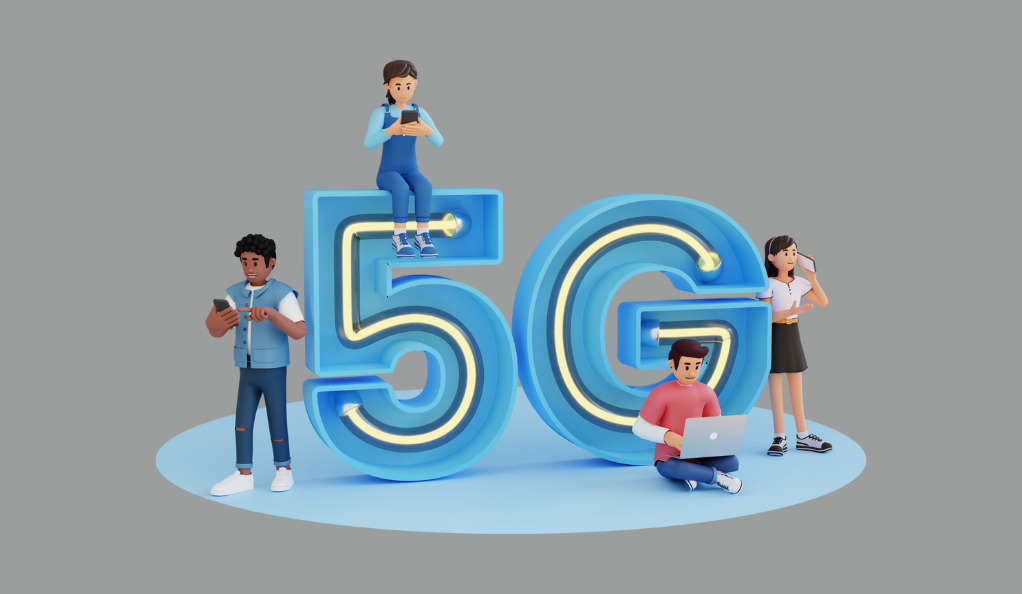The manufacturing sector, a linchpin of the global economy, has historically been a crucible for innovation. Today, as we stand on the cusp of the Fourth Industrial Revolution, the industry is witnessing a transformative shift, propelled by a suite of innovative and emerging advanced manufacturing technologies. These aren’t mere incremental improvements; they are paradigm shifts that are reimagining how products are conceptualized, designed, and produced.
A Historical Perspective: The Manufacturing Timeline
To truly appreciate the transformative power of these technologies, it’s instructive to journey through the annals of manufacturing history:
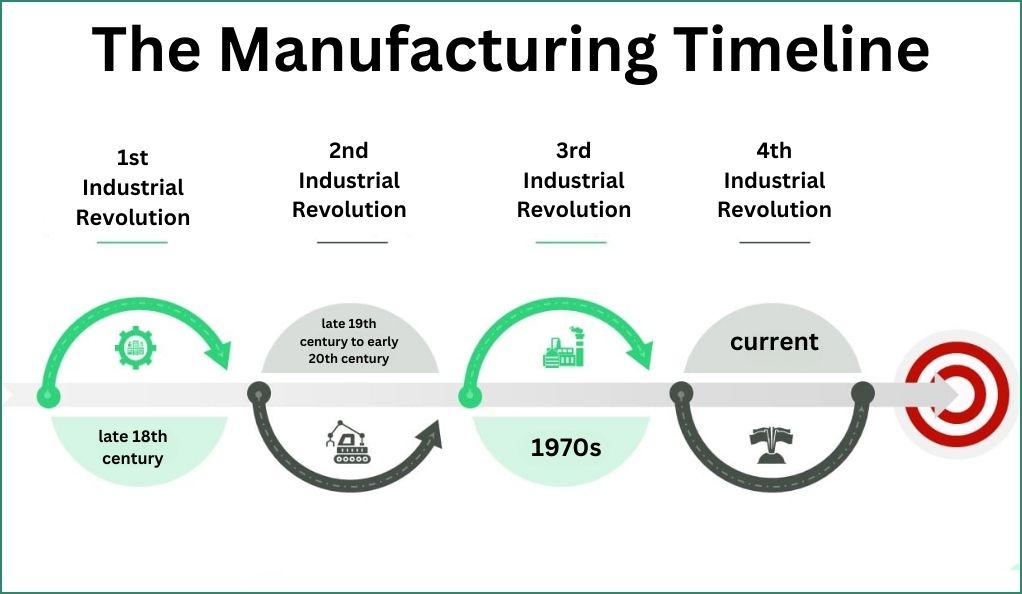
- 1st Industrial Revolution (late 18th century): The era of mechanization. Water and steam power replaced manual labor, leading to the birth of mechanized factories.
- 2nd Industrial Revolution (late 19th century to early 20th century): The age of discovery. Electricity replaced steam, enabling mass production. Assembly lines became the norm, and industries like steel and oil dominated.
- 3rd Industrial Revolution (1970s): The digital revolution. Electronics and IT started automating production, leading to the rise of computers and robots in factories.
- 4th Industrial Revolution (current): The era of intelligence. A fusion of technologies blurs the lines between physical, digital, and biological spheres. AI, IoT, and robotics are at the forefront.
Spotlight on Key Advanced Manufacturing Technologies
Let’s take a more detailed look at the technologies that are steering modern manufacturing:
- Additive Manufacturing (3D Printing):
- Description: Beyond just a prototyping tool, 3D printing is now used for full-scale production. It builds objects layer by layer, directly from digital models.
- Benefits: Enables rapid prototyping, reduces material waste, and allows for intricate designs previously deemed impossible.
- Applications: From jet engine parts in aerospace to prosthetics in healthcare.
- Advanced Robotics and Automation:
- Description: Modern robots are collaborative, working alongside humans. They’re equipped with advanced sensors, allowing them to adapt to variable environments.
- Benefits: Increases production speed, ensures consistent quality, and can operate in environments hazardous to humans.
- Applications: Robots now paint cars, assemble intricate electronics, and even pick and pack products in warehouses.
- Artificial Intelligence (AI) in Manufacturing:
- Description: AI algorithms analyze vast datasets to optimize processes, predict maintenance needs, and even design products.
- Benefits: Reduces downtime, ensures product quality, and optimizes supply chains.
- Applications: AI is used in quality control in semiconductor manufacturing and demand forecasting in consumer goods.
- Nanomanufacturing:
- Description: This involves manipulating materials at an atomic or molecular scale to produce nanoscale products.
- Benefits: Products have enhanced electrical, chemical, and mechanical properties.
- Applications: Used in creating high-performance batteries, targeted drug delivery systems, and more efficient solar cells.
- Advanced Materials and Composites:
- Description: These are materials engineered to have superior properties not found in nature.
- Benefits: They can be lighter, stronger, or more resistant to temperature and corrosion than traditional materials.
- Applications: Carbon-fiber composites are used in aircraft, and advanced ceramics are found in medical implants.
Historical Perspective: Traditional vs. Advanced Manufacturing
The story of manufacturing is a tale of evolution, reflecting the broader narrative of human progress. From the rudimentary techniques of ancient civilizations to the sophisticated processes of the modern era, manufacturing has been a mirror to our technological and societal advancements. To truly grasp the depth of this transformation, we must delve deeper into the nuances of traditional and advanced manufacturing.
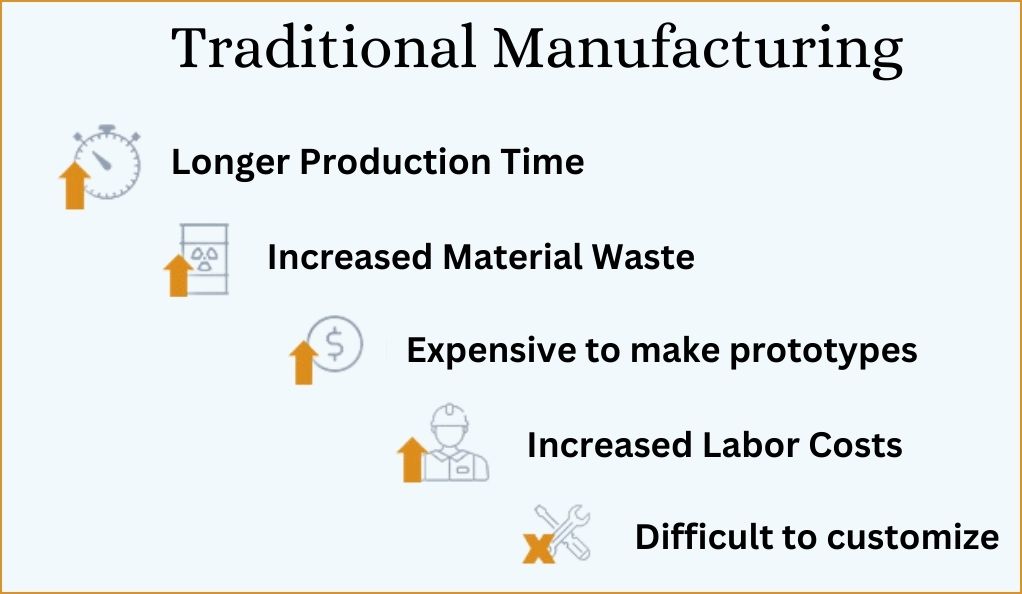
Traditional Manufacturing: The Bedrock of Civilization
Traditional manufacturing is as old as civilization itself. It’s the process that gave us the Pyramids, the Great Wall of China, and the cathedrals of Europe.
Key Features:
- Craftsmanship: Each product was a testament to the artisan’s skill, often passed down through generations.
- Resource Dependency: Materials used were typically local, leading to regional variations in products.
- Simplicity: Tools were basic, often powered by human or animal effort.
- Economic Impact: Manufacturing was localized, with communities often built around local production hubs.
Evolutionary Milestones in Traditional Manufacturing:
- Stone Age: Use of stone tools for crafting everyday items.
- Bronze & Iron Ages: Introduction of metalworking, leading to stronger tools and weapons.
- Medieval Period: Guild systems emerged, standardizing production techniques and ensuring quality.
Advanced Manufacturing: The Technological Renaissance
Advanced manufacturing is a testament to the human spirit’s relentless pursuit of innovation. It’s the process that’s giving us smart devices, electric cars, and space rockets.
Key Features:
- Automation: Machines take on tasks previously done by humans, ensuring speed and precision.
- Interconnectivity: The rise of the Internet of Things (IoT) means machines “talk” to each other, optimizing the production process.
- Flexibility: Rapid prototyping and modular manufacturing allow for quick design changes.
- Sustainability: A focus on reducing waste and energy consumption.
Evolutionary Milestones in Advanced Manufacturing:
- Late 18th to Early 19th Century: The steam engine revolutionized production, leading to the first factories.
- Early 20th Century: The assembly line, introduced by Henry Ford, made mass production possible.
- Late 20th Century: Computers introduced automation into factories.
- 21st Century: AI, robotics, and 3D printing are redefining the limits of what’s possible.
Side-by-Side: Traditional vs. Advanced Manufacturing
| Criteria | Traditional Manufacturing | Advanced Manufacturing |
|---|---|---|
| Primary Focus | Craftsmanship | Efficiency & Precision |
| Scale | Small to Medium | Large to Global |
| Customization | High (each product is unique) | Variable (mass customization) |
| Production Time | Longer (manual processes) | Shorter (automation) |
| Labor | Artisans & Manual Laborers | Technicians & Engineers |
| Environmental Impact | Limited (localized production) | Significant but offset by green technologies |
The Broader Implications
The shift from traditional to advanced manufacturing is not just about technology; it’s about societal change. Advanced manufacturing demands a skilled workforce, leading to an emphasis on education and training. It also raises questions about job displacement due to automation and the ethical implications of AI-driven production.
Moreover, as manufacturing becomes more global, it brings both opportunities and challenges. On one hand, it leads to economic growth and innovation. On the other, it raises concerns about sustainability, supply chain vulnerabilities, and the loss of traditional craftsmanship.
Emerging Economies: Leading the Way in Manufacturing Innovation
The global manufacturing landscape is undergoing a transformative shift, with emerging economies emerging as powerhouses of innovation and production. These nations, once perceived as low-cost manufacturing hubs, are now at the forefront of technological advancements, research, and development in the sector. Their journey from being passive players to active innovators is a testament to their resilience, adaptability, and vision.
Backdrop: The Global Shift to Emerging Economies
The late 20th century witnessed a significant migration of manufacturing bases to emerging economies. This shift was initially driven by cost-saving pursuits, but over time, the narrative has evolved.
Factors Fueling the Shift:
- Economic Liberalization: Many emerging economies opened their markets to foreign investments, offering incentives and easing regulations.
- Demographic Advantage: A burgeoning young population provided a vast labor pool.
- Strategic Geographical Locations: Proximity to raw materials and potential markets gave a logistical edge.
Beyond Cost: The Innovation Drive
Emerging economies have transcended the cost advantage paradigm. They’re now hubs for innovation, research, and development.
Innovation Landscapes:
- Research & Development (R&D) Centers: Multinational corporations are setting up R&D centers, tapping into local talent pools.
- Start-up Ecosystems: Cities like Bangalore, Shenzhen, and São Paulo are becoming global start-up hubs, fostering innovation in manufacturing tech.
- Collaborative Ventures: Partnerships between local institutions and global entities are driving research in advanced manufacturing technologies.
Emerging Economies: A Closer Look
- China: Beyond being the world’s manufacturing behemoth, China is leading in sectors like electronics, renewable energy, and electric vehicles. The nation’s “Made in China 2025” initiative aims to upgrade its manufacturing base, focusing on high-tech fields.
- India: The “Make in India” initiative has rejuvenated the manufacturing sector, with a focus on aerospace, defense, and electronics. India’s IT prowess is also driving innovations in software-integrated manufacturing solutions.
- Brazil: Brazil’s manufacturing strength lies in its aerospace, automotive, and agri-tech sectors. The nation is also investing heavily in bio-manufacturing and sustainable production methods.
- Vietnam: Vietnam’s strategic location and investment-friendly policies have made it a favorite for electronics and textile manufacturing. The country is also focusing on developing its tech start-up ecosystem, which will further drive manufacturing innovations.
- South Africa: As Africa’s industrial powerhouse, South Africa is focusing on automotive, agri-tech, and mineral processing innovations. The nation is also playing a pivotal role in promoting intra-Africa trade and manufacturing collaborations.
Comparison Table: Manufacturing Evolution in Emerging vs. Developed Economies
| Criteria | Emerging Economies | Developed Economies |
|---|---|---|
| Innovation Drivers | Cost advantage, demographic dividend, local market potential | Established R&D infrastructure, technological legacy |
| Key Sectors | Electronics, textiles, automotive | Aerospace, pharmaceuticals, high-tech electronics |
| Investment Focus | Infrastructure development, skill enhancement | R&D, sustainability initiatives |
| Challenges | Regulatory complexities, skill gaps, infrastructure bottlenecks | High operational costs, aging workforce, market saturation |
| Future Prospects | Diversification, upskilling, tech adoption | Sustainability, re-shoring, niche market innovations |
The Road Ahead: Challenges and Prospects
Emerging economies, despite their impressive strides, face challenges:
- Intellectual Property (IP) Concerns: Ensuring IP protection is crucial to foster innovation and attract investments.
- Sustainability: Balancing rapid industrialization with environmental concerns is vital.
- Quality Standards: Meeting global quality standards consistently is essential for global market penetration.
However, the prospects are promising:
- Digital Manufacturing: The integration of AI, IoT, and robotics promises a new era of digital manufacturing.
- Sustainable Practices: Emphasis on green manufacturing and circular economy principles can set new global standards.
- Global Collaborations: Partnerships with developed economies can lead to knowledge exchange, funding, and market access.
Key Advanced Manufacturing Technologies to Watch
The manufacturing sector, a cornerstone of the global economy, is in the midst of a technological renaissance. Advanced manufacturing technologies are not just enhancing production capabilities but are also revolutionizing the very essence of how products are conceptualized, designed, and brought to market. As we stand on the cusp of the Fourth Industrial Revolution, here are the key advanced manufacturing technologies that are shaping the future.
Additive Manufacturing (3D Printing)
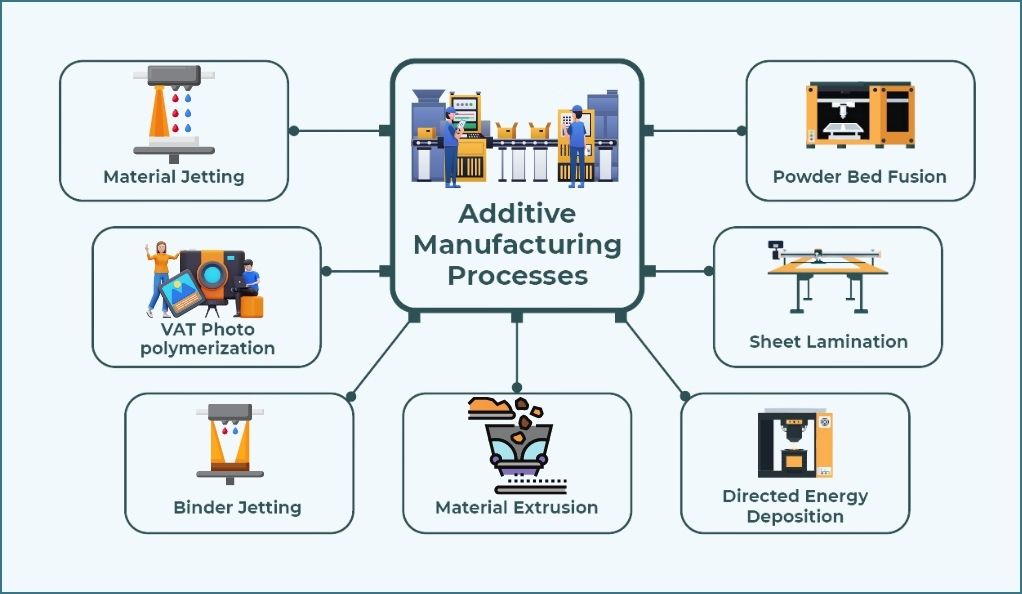
Additive manufacturing, commonly known as 3D printing, involves creating objects by depositing materials layer by layer based on a digital model. It’s a stark departure from traditional subtractive manufacturing methods.
Key Features:
- Flexibility: Ability to produce complex geometries that are impossible with traditional methods.
- Customization: Ideal for bespoke manufacturing and prototyping.
- Material Diversity: Can use plastics, metals, ceramics, and even biological materials.
Applications: Aerospace components, medical implants, automotive parts, fashion and jewelry.
Advanced Robotics and Automation
Modern robotics in manufacturing is about more than just automation. These robots are equipped with sensors, AI, and machine learning capabilities, allowing them to perform complex tasks and adapt to changing environments.
Key Features:
- Collaborative Robots (Cobots): Designed to work alongside humans without the need for safety barriers.
- Precision: Ability to perform tasks with high accuracy and repeatability.
- Adaptability: Can be reprogrammed for different tasks, offering flexibility.
Applications: Car assembly, electronics manufacturing, product packaging, and quality control.
Artificial Intelligence (AI) and Machine Learning
AI algorithms analyze vast datasets to optimize manufacturing processes, predict maintenance needs, and even assist in product design.
Key Features:
- Predictive Maintenance: Predict when machinery will fail, reducing downtime.
- Quality Control: Automated checks using AI-driven vision systems.
- Supply Chain Optimization: Forecasting demand and optimizing inventory.
Applications: Semiconductor manufacturing, food and beverage quality control, textiles.
Nanomanufacturing
This involves manipulating materials at an atomic or molecular scale to produce products with enhanced properties.
Key Features:
- Enhanced Properties: Products can have improved electrical, chemical, or mechanical properties.
- Miniaturization: Allows for the production of extremely small components.
- Precision: Ability to manipulate individual molecules.
Applications: Advanced electronics, drug delivery systems, high-performance coatings.
Internet of Things (IoT) in Manufacturing
IoT involves connecting various devices and machinery to the internet, allowing for real-time data collection and analysis.
Key Features:
- Real-time Monitoring: Track production metrics in real-time.
- Remote Control: Machinery can be controlled remotely.
- Predictive Analysis: Analyze data to predict trends and optimize processes.
Applications: Smart factories, supply chain management, energy consumption monitoring.
Comparison Table: Advanced Manufacturing Technologies
| Technology | Key Benefit | Notable Application | Future Potential |
|---|---|---|---|
| 3D Printing | Rapid Prototyping | Aerospace | Bioprinting organs |
| Advanced Robotics | Precision & Flexibility | Automotive Assembly | Fully autonomous factories |
| AI in Manufacturing | Process Optimization | Quality Control | Fully AI-driven design |
| Nanomanufacturing | Enhanced Material Properties | Electronics | Nano-robots for medical applications |
| IoT | Real-time Monitoring | Smart Factories | Fully interconnected global supply chains |
The Broader Implications
The integration of these advanced manufacturing technologies promises a future where factories are more agile, efficient, and sustainable. However, this also brings challenges such as the need for skilled labor, cybersecurity concerns, and the potential for job displacement. As industries adapt to these technologies, continuous training, ethical considerations, and regulatory frameworks will be crucial.
Benefits of Adopting Advanced Manufacturing Technologies
The manufacturing sector, historically seen as a bastion of traditional methods, is undergoing a profound transformation. This metamorphosis is driven by the adoption of advanced manufacturing technologies. While the initial investment in these technologies might seem daunting, the benefits they offer are manifold and can lead to significant long-term gains. Let’s delve deep into the myriad advantages of embracing these cutting-edge technologies.
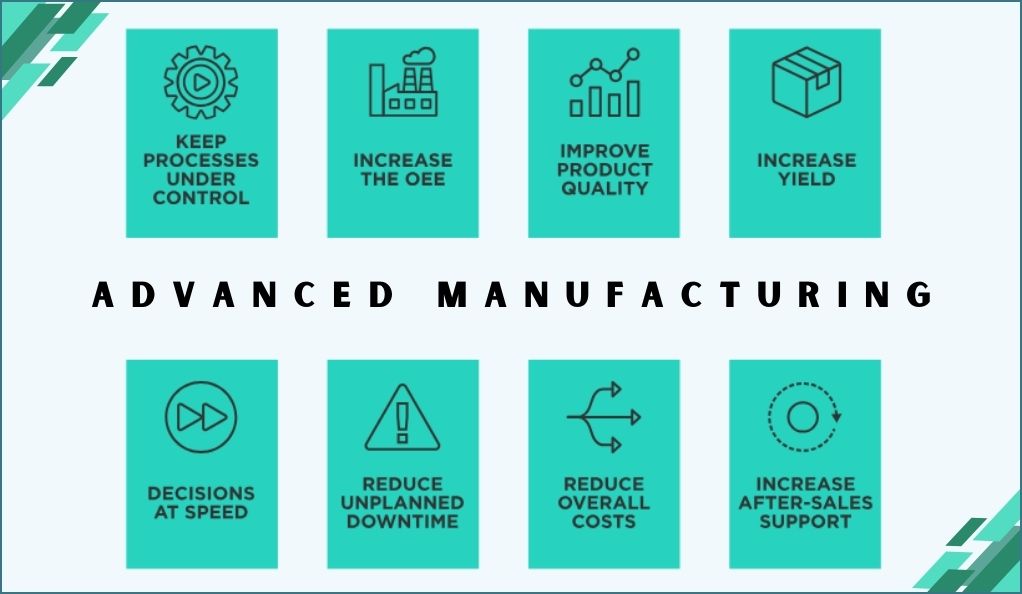
Enhanced Product Quality
Advanced manufacturing technologies allow for greater precision and consistency in production processes.
Benefits:
- Reduced Errors: Automated systems minimize human errors.
- Consistent Output: Each product is manufactured to the exact same specifications, ensuring uniformity.
- Advanced Quality Control: Technologies like AI-driven vision systems can detect and rectify defects in real-time.
Increased Production Efficiency
Speed and efficiency are of the essence in today’s competitive market. Advanced technologies streamline and optimize production processes.
Benefits:
- Faster Production: Automated machinery can operate continuously without breaks.
- Optimized Workflow: AI algorithms can analyze production data to identify and eliminate bottlenecks.
- Resource Efficiency: Advanced systems ensure optimal utilization of raw materials, reducing waste.
Cost Savings
While the initial investment in advanced technologies can be high, the long-term cost savings are substantial.
Benefits:
- Reduced Labor Costs: Automation reduces the need for manual labor.
- Energy Efficiency: Modern machines are designed to consume less energy.
- Waste Reduction: Precise manufacturing methods and predictive analytics can significantly reduce material wastage.
Customization and Flexibility
Today’s consumers demand products tailored to their specific needs. Advanced manufacturing technologies make mass customization feasible.
Benefits:
- Rapid Prototyping: Technologies like 3D printing allow for quick production of prototypes.
- Flexible Production Lines: Modern machinery can be quickly reconfigured to produce different products.
- Personalized Products: AI-driven systems can customize products based on individual consumer preferences.
Sustainability and Environmental Benefits
As global emphasis on sustainability grows, advanced manufacturing technologies offer solutions to reduce the environmental footprint of production processes.
Benefits:
- Reduced Emissions: Energy-efficient machines emit fewer greenhouse gases.
- Recycling and Upcycling: Advanced processes can reuse and repurpose waste materials.
- Green Manufacturing: Adoption of technologies focused on producing eco-friendly products.
Comparison Table: Traditional vs. Advanced Manufacturing Benefits
| Criteria | Traditional Manufacturing | Advanced Manufacturing |
|---|---|---|
| Production Speed | Moderate | High |
| Customization | Limited | High (Mass Customization) |
| Efficiency | Variable | Optimized (AI & Automation) |
| Waste Production | Higher | Reduced (Precision & Analytics) |
| Environmental Impact | Higher | Lower (Eco-friendly Technologies) |
The Bigger Picture
The adoption of advanced manufacturing technologies is not just about enhancing production capabilities; it’s about building a resilient, sustainable, and competitive manufacturing sector. Companies that embrace these technologies are better positioned to adapt to market changes, meet consumer demands, and contribute to a sustainable future.
Moreover, these technologies pave the way for a more interconnected global manufacturing ecosystem. With real-time data sharing, predictive analytics, and collaborative robots, factories of the future will be more agile and responsive.
Challenges and Barriers to Adoption
The rapid pace of technological advancement promises a brighter, more efficient future across various sectors. However, the path to this future is riddled with challenges and barriers that often hinder the widespread adoption of these innovations. Whether it’s a new software solution, an advanced manufacturing technology, or a groundbreaking medical procedure, the journey from conception to mainstream acceptance is rarely straightforward. Let’s delve into the multifaceted challenges and barriers that organizations and societies face when trying to adopt new technologies and methodologies.
Financial Constraints
The initial investment required for cutting-edge technologies can be substantial.
Challenges:
- High Upfront Costs: Advanced equipment, software, or infrastructure often come with hefty price tags.
- Return on Investment (ROI) Uncertainty: It might take time before the benefits of the investment become apparent, leading to hesitancy.
- Maintenance and Upgradation Costs: Over time, technologies might require updates, further training, or maintenance, adding to the overall cost.
Skill Gap and Workforce Training
New technologies often demand specialized skills that the current workforce might not possess.
Challenges:
- Lack of Trained Personnel: A scarcity of individuals trained in the new technology can hinder its implementation.
- Training Costs: Organizations might need to invest heavily in training programs.
- Resistance to Change: Existing employees might resist transitioning to new systems or methodologies.
Infrastructure Limitations
The adoption of new technologies might necessitate significant changes to existing infrastructure.
Challenges:
- Incompatibility: Existing systems might not be compatible with the new technology.
- Upgrade Challenges: Infrastructure upgrades can be time-consuming and disruptive.
- Dependency on External Vendors: Some technologies might rely on third-party providers, leading to potential vulnerabilities.
Regulatory and Compliance Hurdles
Especially in sectors like healthcare, finance, and aerospace, regulatory compliance is paramount.
Challenges:
- Ever-evolving Regulations: Keeping up with changing regulations can be daunting.
- Certification Delays: Getting new technologies certified can be a lengthy process.
- Legal Implications: Potential legal ramifications if the technology fails or causes harm.
Cultural and Organizational Resistance
Organizational culture plays a significant role in the adoption of new technologies.
Challenges:
- Fear of the Unknown: Employees might be wary of how new technologies will affect their roles.
- Organizational Inertia: Established organizations might resist change due to entrenched ways of doing things.
- Lack of Vision: Without a clear vision from leadership, adoption can be slow and disjointed.
Comparison Table: Challenges Across Different Sectors
| Sector | Primary Challenge | Secondary Challenge | Tertiary Challenge |
|---|---|---|---|
| Healthcare | Regulatory Hurdles | Financial Constraints | Skill Gap |
| Manufacturing | Infrastructure Limitations | Skill Gap | Financial Constraints |
| Finance | Regulatory Hurdles | Cultural Resistance | Infrastructure Limitations |
| Education | Cultural Resistance | Financial Constraints | Skill Gap |
The Silver Lining: Overcoming Barriers
While the challenges are significant, they’re not insurmountable. Organizations and societies can adopt several strategies:
- Stakeholder Engagement: Engaging all stakeholders, from employees to regulators, can ensure smoother adoption.
- Pilot Programs: Testing technologies on a smaller scale can help identify potential issues and solutions.
- Continuous Learning: Emphasizing a culture of continuous learning can help bridge the skill gap.
- Collaborative Approach: Collaborating with technology providers can lead to customized solutions that address specific challenges.
The Future of Manufacturing: Predictions and Trends
The manufacturing sector, a linchpin of the global economy, is on the brink of a transformative era. As technological advancements continue to reshape industries, manufacturing stands at the crossroads of tradition and innovation. The future promises a blend of enhanced capabilities, sustainability, and a new paradigm of production. Let’s explore the predictions and trends that are set to define the future of manufacturing.
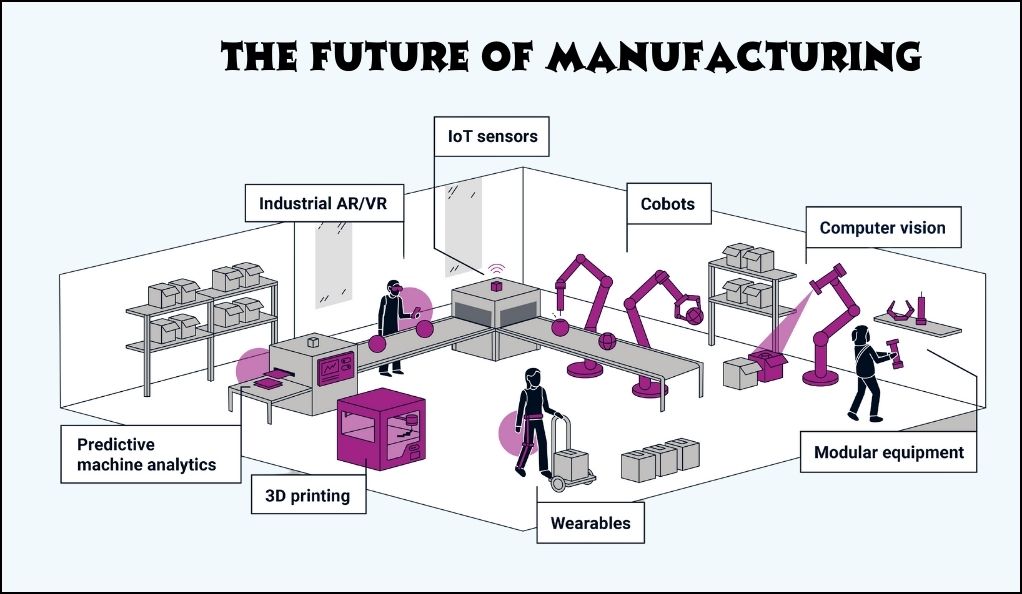
Smart Manufacturing and Industry 4.0
The Fourth Industrial Revolution, or Industry 4.0, represents the convergence of physical production and digital technologies.
Trends:
- Internet of Things (IoT): Machines, devices, and humans will be interconnected, sharing data in real-time.
- Big Data and Analytics: Data-driven insights will optimize production processes, reduce waste, and enhance product quality.
- Autonomous Robots: Advanced robots will work alongside humans, taking over repetitive tasks and even making decisions based on AI algorithms.
Sustainability and Circular Economy
Environmental concerns are pushing manufacturers towards sustainable practices and a circular economy model.
Trends:
- Green Manufacturing: Emphasis on reducing carbon footprint, waste, and energy consumption.
- Resource Efficiency: Advanced technologies will ensure optimal utilization of raw materials.
- Recycling and Upcycling: End-of-life products will be repurposed, reducing the need for virgin materials.
Mass Customization
The one-size-fits-all approach is giving way to mass customization, where products are tailored to individual preferences.
Trends:
- Flexible Production Lines: Rapid reconfiguration of production lines to cater to diverse product specifications.
- Direct-to-Consumer Models: Advanced manufacturing technologies will enable manufacturers to produce on-demand, reducing inventory costs.
- 3D Printing: Additive manufacturing will play a pivotal role in producing customized products at scale.
Global Supply Chain Resilience
Recent disruptions have highlighted vulnerabilities in global supply chains.
Trends:
- Diversification: Manufacturers will diversify suppliers to mitigate risks.
- Nearshoring: A shift towards producing closer to consumption markets to reduce logistics challenges.
- Digital Twins: Virtual replicas of physical systems will allow manufacturers to simulate and optimize supply chain processes.
Advanced Materials and Nanotechnology
The quest for better, more efficient materials is driving innovations in material science.
Trends:
- Composite Materials: Materials that combine the best properties of multiple components.
- Nanomaterials: Manipulating materials at the atomic or molecular level will lead to products with enhanced properties.
- Bio-based Materials: Sustainable materials derived from renewable biological sources.
Comparison Table: Traditional vs. Future Manufacturing Trends
| Criteria | Traditional Manufacturing | Future Manufacturing Trends |
|---|---|---|
| Production Model | Mass Production | Mass Customization |
| Supply Chain | Linear & Centralized | Diversified & Resilient |
| Sustainability | Limited Focus | Central to Operations |
| Technological Integration | Basic Automation | IoT, AI, and Robotics |
| Materials | Standard Materials | Advanced & Sustainable Materials |
The Broader Implications
The future of manufacturing is not just about technological advancements; it’s about a holistic transformation. This evolution will have ripple effects:
- Workforce Dynamics: The demand for specialized skills will grow, emphasizing the need for continuous learning and training.
- Economic Shifts: As manufacturing becomes more decentralized, we might witness a shift in global economic power dynamics.
- Ethical Considerations: The integration of AI and automation raises questions about job displacement, data privacy, and ethical production.
Conclusion: Navigating the Tapestry of Progress
In the intricate dance of history, progress, and innovation, conclusions serve as pivotal moments of reflection. They encapsulate the wisdom gleaned from past experiences, the dynamism of the present, and the aspirations for the future. The journey from industrialization to the digital age has been marked by transformative shifts, each leaving an indelible impact on our collective psyche. These epochs, while distinct, are interconnected, shaping the contours of our global narrative.
As we stand at the crossroads of the present, poised to leap into a future dominated by sustainability and ethical considerations, it’s imperative to harness the lessons of the past. The challenges and triumphs of yesteryears provide invaluable insights, guiding our path forward. In this ever-evolving landscape, our ability to draw informed conclusions will be instrumental in crafting a future that resonates with our shared ideals and collective aspirations. The essence of these reflections is not just to summarize but to inspire, guide, and set the stage for the chapters yet to be written.

